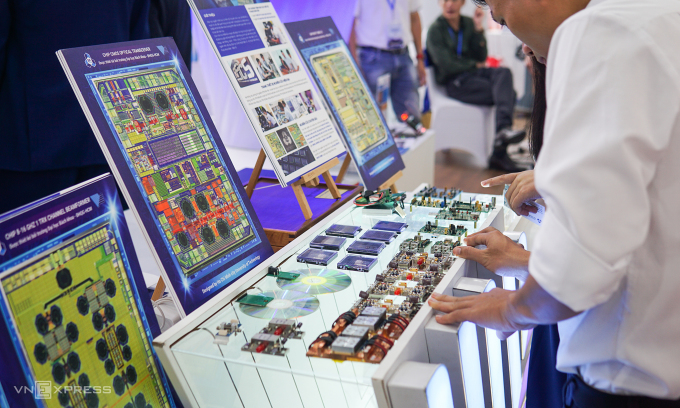Vietnamese semiconductor workforce trails South Korea and China's in competitiveness – VnExpress International
Chung Won Soek, general director of South Korea’s Hana Micron Vina, a company specializing in manufacturing and processing integrated circuit boards for mobile phones and smart devices that has two factories located in Bac Giang and Bac Ninh provinces in northern Vietnam, said that although the Vietnamese workforce in this sector is young, their standards and competitiveness are weaker than those of South Korea and China.
“For example, in terms of job proficiency, if a Vietnamese worker can operate the equipment 18 times on average, a Chinese worker can do so 40 times and it would be 60 times for a South Korean.”
The company’s Bac Giang facility can produce 100 million semiconductor chips per year, employing more than 1,600 workers, with plans to increase this to 1,900 by the end of the year.
However, senior staff still make up a low percentage, with skilled workers accounting for 39%, equipment engineers about 23%, and process engineers about 29%, requiring significant training time to master the processes, Chung told a seminar held on Tuesday in Bac Giang.
General director Chung Won Soek of Hana Micron Vina company in Bac Giang Province at a seminar on April 16, 2024. Photo by VnExpress/Hong Chieu
When comparing the ability to maintain and repair faulty equipment, Vietnamese engineers scored 30 points, while China scored 70 and South Korea 90, Chung said.
The work experience and tenure with the company of Vietnamese workers are also much less, he added.
Chung described the situation as “understandable,” noting that Vietnam’s semiconductor industry is relatively new. He believes that with enhanced training and development, Vietnam can achieve parity with South Korea and China.
To supply the workforce, the company is currently cooperating with colleges to offer training courses.
Students in the program are directly taught by engineers from Hana Micron Vina at their schools and then take internship programs at the company. Those who pass two internships will be chosen to work at the company.
With the program, Chung hopes to find high-quality personnel for the semiconductor industry.
Since the end of 2022, the company has organized two internships for nearly 120 students and has so far hired over 60 of them.
Nguyen Xuan Ngoc, Deputy Director of Bac Giang’s Management Board of Industrial Zones, said there is still a lack of formal workforce in this field.
“Those working in this field were previously trained for other industries, such as automation, electronic engineering, electronic equipment, information technology, mechanical engineering, and chemical technology,” Ngoc said. “As a result, companies have had to train their employees from scratch.”
People who have been trained for a few months can perform basic tasks but still need the supervision of managers and technical experts.
“It typically takes at least a year for them to become proficient and work independently. Therefore, schools should closely align their training courses with market and business needs,” Ngoc added.
He promised that the management board will act as a bridge between businesses and schools to build a system and provide information on market needs and trends.
Made-in-Vietnam integrated circuit products on display at an event in HCMC in October 2023. Photo by VnExpress/Luu Quy
Yet the sector is also short of trainers and lecturers.
Vo Xuan Hoai, deputy director of the National Innovation Center, believes that infrastructure and high-tech equipment for training require significant investment from the government, institutions, and businesses. The coordination between schools and businesses with regular training programs is not yet consistent and does not meet international standards.
“We need more policies to encourage engineering students to enter the semiconductor field,” Hoai said, suggesting that Bac Giang improve the capacity of universities, allocate budgets for short-term practical training projects or postgraduate studies.
Minister of Information and Communications Nguyen Manh Hung said last September that the semiconductor industry would need 10,000 engineers every year by 2030, but the current rate is less than 20% of the target.
The number of engineers has only been growing by around 500 a year, according to a report by the Vietnam Microchip Community.
Subsidiary of VnExpress
License number: 71/GP-CBC, Ministry of Information and Communications, September 22, 2021
© Copyright 1997 VnExpress.net. All rights reserved.
